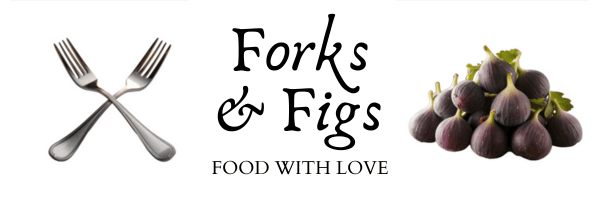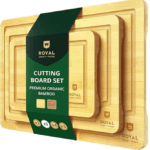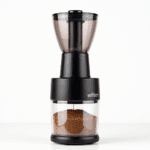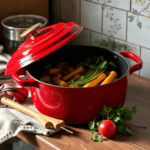Authentic Pakistani Nihari Recipe: Slow-Cooked Beef Bliss
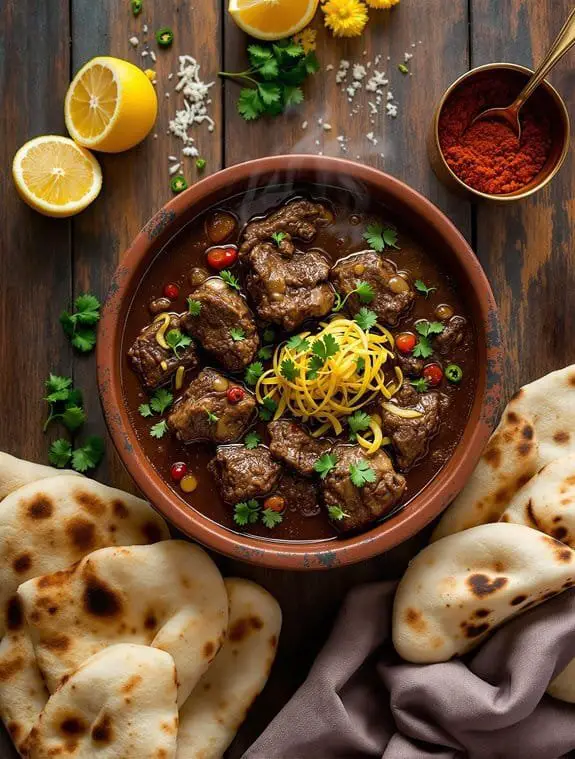
I’m about to share something that’ll transform your weekend cooking game forever. This isn’t just any beef stew – it’s Pakistani nihari, a dish so rich and aromatic that it practically demands you slow down and savor every single bite. The kind of meal that fills your kitchen with scents so incredible, your neighbors might start “accidentally” dropping by around dinnertime. But here’s the thing most people get completely wrong about making authentic nihari.
Why You’ll Love this Authentic Pakistani Nihari
While many comfort foods promise to warm your soul, Pakistani Nihari actually delivers on that promise with its rich, aromatic broth that’s been slowly simmered to perfection.
I can practically guarantee you’ll fall in love with this dish after your first spoonful.
The complex spice blend creates layers of flavor that’ll have you wondering why you ever settled for boring stews.
Plus, the tender beef literally falls apart with a fork – no wrestling required.
It’s comfort food that actually comforts, not just fills you up.
What Ingredients are in Authentic Pakistani Nihari?
Creating authentic Pakistani Nihari requires a carefully curated collection of ingredients that work together to build those signature layers of flavor. The shopping list might look intimidating at first glance, but trust me, each ingredient plays a vital role in creating that soul-warming broth you’re after.
The beauty of this recipe lies in its simplicity despite the long ingredient list. Most of what you need falls into three main categories: the meat and bones for richness, the aromatic spice blend that makes Nihari so special, and the fresh garnishes that brighten each bowl.
Main Ingredients:
- 2 pounds beef chunks (shank or stew meat work best)
- 1-2 pounds beef bones
- 2 tablespoons salt
- 1½ tablespoons ginger paste
- 1½ tablespoons garlic paste
- 1 tablespoon red chili powder
- 1 tablespoon Kashmiri chili powder
- 1 tablespoon coriander powder
- ½ teaspoon turmeric powder
- Ghee or oil for cooking
- 1 large onion
Nihari Masala Spice Blend:
- 1½ tablespoons coriander seeds
- 1½ tablespoons fennel seeds
- 1½ teaspoons black peppercorns
- 1½ teaspoons cloves
- ½ tablespoon cumin seeds
- 1 bay leaf
- ½ teaspoon nutmeg
- 2 cinnamon sticks (1-inch pieces)
- 2-3 mace pieces
- 3 black cardamoms
- 4-6 green cardamoms
- 1 piece dried ginger (or ½ tablespoon powder)
- 6 dried red chilies
- 1 teaspoon kalonji (nigella seeds)
Fresh Garnishes:
- Lemon wedges
- Sliced green chilies
- Julienned fresh ginger
Finding the Right Ingredients
The beef bones are absolutely non-negotiable here, so don’t even think about skipping them. They’re what transform ordinary broth into that rich, gelatinous liquid gold that coats your spoon. Ask your butcher for marrow bones or knuckle bones, and they’ll know exactly what you need.
Kashmiri chili powder might require a trip to an Indian or Pakistani grocery store, but it’s worth the hunt. This particular chili powder gives Nihari its signature deep red color without overwhelming heat. If you can’t find it, you can substitute with paprika mixed with a pinch of regular chili powder, though the color won’t be quite as vibrant.
The whole spices for the Nihari masala are where the magic happens. Black cardamoms have a completely different flavor profile than green ones, so don’t substitute. They’re smoky and earthy, while green cardamoms are floral and sweet.
Kalonji, also called nigella seeds, adds a subtle onion-like flavor that rounds out the spice blend beautifully.
How to Make this Authentic Pakistani Nihari
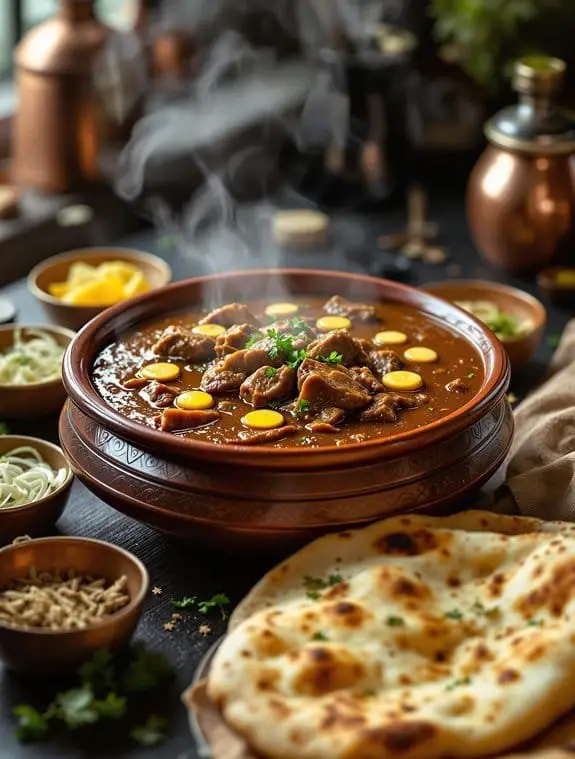
Making authentic Pakistani Nihari is like conducting a slow, aromatic symphony in your kitchen. The process takes time, but honestly, that’s half the charm. You can’t rush perfection, and Nihari definitely falls into the “good things come to those who wait” category.
Start with the Spice Foundation
Your first mission is creating that legendary Nihari masala blend. Take all those whole spices – the 1½ tablespoons coriander seeds, 1½ tablespoons fennel seeds, 1½ teaspoons black peppercorns, 1½ teaspoons cloves, ½ tablespoon cumin seeds, 1 bay leaf, ½ teaspoon nutmeg, 2 cinnamon sticks, 2-3 mace pieces, 3 black cardamoms, 4-6 green cardamoms, 1 piece dried ginger, 6 dried red chilies, and 1 teaspoon kalonji – and dry roast them in a heavy-bottomed pan.
Keep the heat on medium and stir constantly because nobody wants burnt spices ruining their masterpiece. You’ll know they’re ready when your kitchen smells like heaven and the spices start releasing their oils, usually after 3-4 minutes. Let them cool completely before grinding them into a fine powder. Trust me, hot spices and blender blades don’t play nice together.
Build Your Flavor Base
Now comes the fun part where your house starts smelling like a Pakistani restaurant. Heat generous amounts of ghee or oil in your heaviest pot – this isn’t the time to be stingy with fat because flavor needs a vehicle.
Slice that 1 large onion thinly and sauté until golden brown, which takes patience but rewards you with sweet, caramelized goodness. Add the 1½ tablespoons ginger paste and 1½ tablespoons garlic paste to those beautiful onions. Cook just until fragrant, maybe 30 seconds, because nobody wants bitter garlic ruining the party. The smell should make your neighbors start asking questions.
Brown the Meat Like a Pro
Time to add those 2 pounds of beef chunks and 1-2 pounds of beef bones to the pot. This step separates the amateurs from the pros – you want to brown that meat properly on all sides.
Don’t overcrowd the pot or you’ll end up steaming instead of searing, and steamed meat is sad meat. Season everything with the 2 tablespoons salt, then add your ground spice mix along with the 1 tablespoon red chili powder, 1 tablespoon Kashmiri chili powder, 1 tablespoon coriander powder, and ½ teaspoon turmeric powder. Stir everything together and let those spices bloom in the fat for a minute or two.
The Long, Slow Journey
Cover your meat with enough water to submerge everything by about 2 inches. Bring it to a boil, then reduce to the lowest simmer your stove can manage.
This is where the magic happens, but it requires serious commitment – we’re talking 4-6 hours of gentle bubbling. Don’t even think about rushing this part with higher heat. Low and slow is the only way to transform tough beef into melt-in-your-mouth tenderness while developing that rich, gelatinous broth that makes Nihari so special.
Check occasionally and add more hot water if needed, but resist the urge to stir constantly.
The Final Touches
After hours of patient simmering, your Nihari should be thick enough to coat a spoon and the meat should fall apart at the touch of a fork. If it’s too thin, simmer uncovered for the last 30 minutes to concentrate those flavors. If it’s too thick, add hot water gradually until you reach that perfect consistency.
Taste and adjust the seasoning because every palate is different, and every batch of spices varies slightly in intensity. The broth should be rich, warming, and complex with layers of flavor that unfold with each spoonful.
Serve your masterpiece hot with fresh garnishes – those lemon wedges, sliced green chilies, and julienned fresh ginger aren’t just pretty additions, they’re flavor bombs that brighten and balance the rich stew. Traditionally, this pairs with naan or simple rice, but honestly, it’s so good you might find yourself eating it straight from the bowl.
Authentic Pakistani Nihari Substitutions and Variations
Since you probably don’t live next to a South Asian grocery store, let me tell you something that’ll save your Nihari dreams – this recipe is surprisingly flexible.
Can’t find beef shank? Chuck roast works beautifully. Missing Kashmiri chili powder? Regular paprika adds that gorgeous red color without the heat.
For the nihari masala, I substitute ground spices when whole ones aren’t available. Sure, freshly ground tastes better, but store-bought garam masala mixed with extra fennel and coriander gets you 80% there.
Vegetarians, try this with jackfruit or mushrooms. The cooking time drops dramatically, but that rich, spiced gravy remains absolutely divine.
What to Serve with Authentic Pakistani Nihari
Now that you’ve got your nihari simmering away, let’s talk about what transforms this stew from good to absolutely mind-blowing – the accompaniments.
Fresh naan is absolutely non-negotiable here. You’ll want something sturdy to scoop up that rich, spiced gravy. I prefer naan over regular bread because it won’t fall apart when you’re diving in.
Don’t skip the garnishes either.
Those lemon wedges add brightness that cuts through the richness, while julienned ginger and green chilies provide pops of heat and freshness.
Trust me, these little touches make all the difference.
Final Thoughts
When you finally ladle that first bowl of nihari after hours of patient cooking, you’ll understand why this dish holds such a special place in Pakistani hearts.
This isn’t just another beef stew recipe. It’s a slow-cooked love letter to your taste buds, a warm hug in a bowl that’ll make your kitchen smell like heaven.
I can almost guarantee your neighbors will start mysteriously lingering by your door.
The rich, spiced gravy paired with fresh naan creates pure magic that no takeout container can replicate.
Trust me, your patience will be rewarded.

Pakistani Nihari
Ingredients
Main Ingredients
- 2 lb beef chunks shank or stew meat
- 1-2 lb beef bones
- 2 tbsp salt
- 1.5 tbsp ginger paste
- 1.5 tbsp garlic paste
- 1 tbsp red chili powder
- 1 tbsp Kashmiri chili powder
- 1 tbsp coriander powder
- ½ tsp turmeric powder
- 3-4 tbsp ghee or oil
- 1 large onion sliced
Nihari Masala
- 1.5 tbsp coriander seeds
- 1.5 tbsp fennel saunf
- 1.5 tsp black peppercorns
- 1.5 tsp cloves
- ½ tbsp cumin seeds
- 1 bay leaf
- ½ tsp nutmeg
- 2 cinnamon sticks 1-inch
- 2-3 mace pieces
- 3 black cardamoms
- 4-6 green cardamoms
- 1 dried ginger piece or ½ tbsp powder
- 6 dried red chilies
- 1 tsp kalonji
Garnish
- Lemon wedges
- Sliced green chilies
- Julienned ginger
Instructions
- Dry roast all Nihari masala spices in a pan over medium heat for 2-3 minutes until fragrant. Cool completely and grind to a fine powder.
- Heat ghee or oil in a large, heavy-bottomed pot. Add sliced onions and sauté until golden brown.
- Add ginger-garlic paste and cook for 1-2 minutes until fragrant.
- Add beef chunks and bones to the pot. Brown the meat well on all sides for 8-10 minutes.
- Add salt, red chili powder, Kashmiri chili powder, coriander powder, turmeric powder, and 2 tbsp of the prepared Nihari masala. Mix well and cook for 2-3 minutes.
- Add enough water to cover the meat by 2 inches. Bring to a boil, then reduce heat to low and simmer covered for 3-4 hours until meat is tender.
- Remove bones from the pot. Increase heat and cook uncovered for 15-20 minutes to thicken the gravy.
- Adjust seasoning with remaining Nihari masala, salt, and spices to taste.
- Serve hot garnished with lemon wedges, sliced green chilies, and julienned ginger alongside fresh naan.
Notes
Nutrition
Frequently Asked Questions
How Long Should I Soak the Beef Before Cooking?
I don’t recommend soaking the beef chunks before cooking nihari. Instead, I’ll brown them directly in the hot ghee after sautéing the onions, which develops better flavor and texture.
Can I Make Nihari in a Pressure Cooker or Slow Cooker?
I recommend using a pressure cooker to reduce cooking time from 6-8 hours to 90 minutes. You’ll still get tender beef and rich flavors, though traditional slow cooking develops slightly deeper taste.
How Do I Store Leftover Nihari and for How Long?
I’ll store your leftover nihari in the refrigerator for up to 3-4 days or freeze it for 2-3 months. I always let it cool completely before transferring to airtight containers.
What’s the Difference Between Pakistani and Indian Nihari?
I’ll explain the key differences between Pakistani and Indian nihari. Pakistani versions typically use more beef bones for richer flavor and heavier spicing, while Indian nihari often incorporates lighter spices and sometimes mutton instead.
Why Is My Nihari Not Thick Enough?
Your nihari isn’t thick enough because you haven’t cooked it long enough or need more flour paste. I’d simmer it longer uncovered or whisk wheat flour with water, then stir it in.
